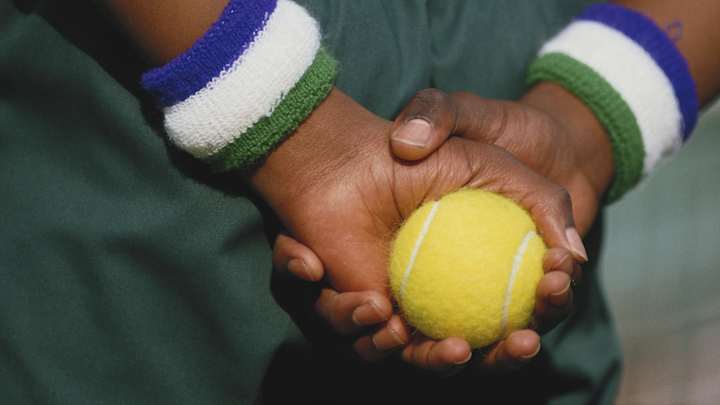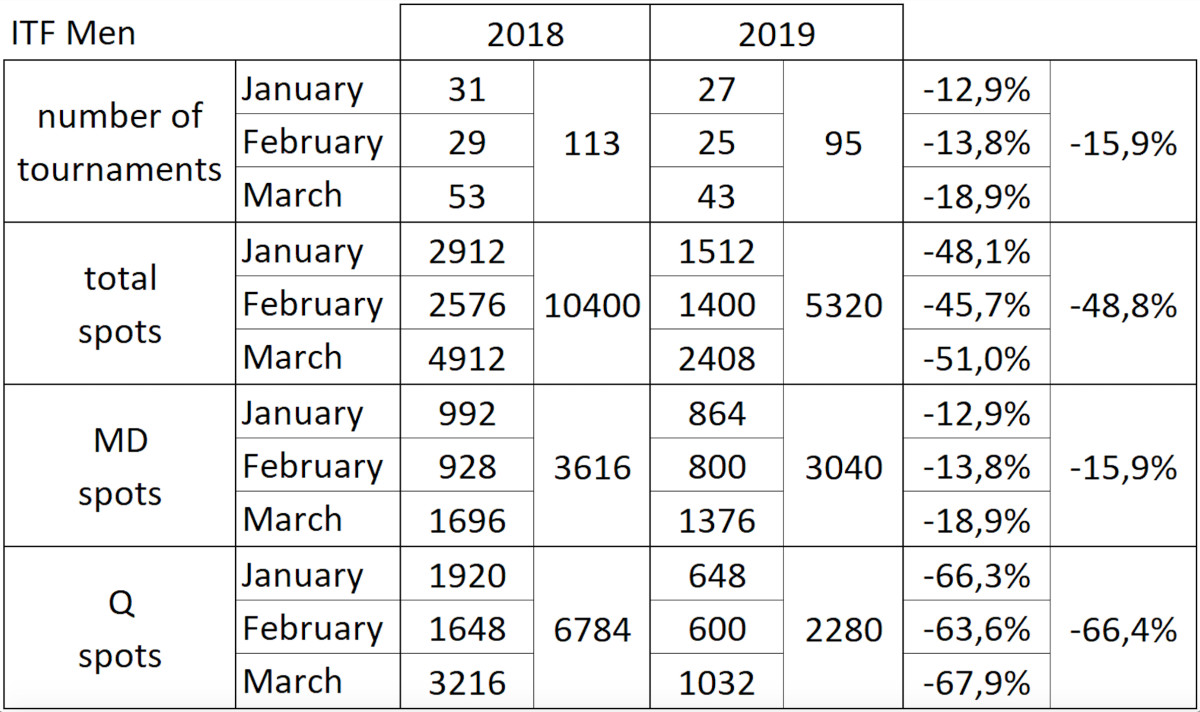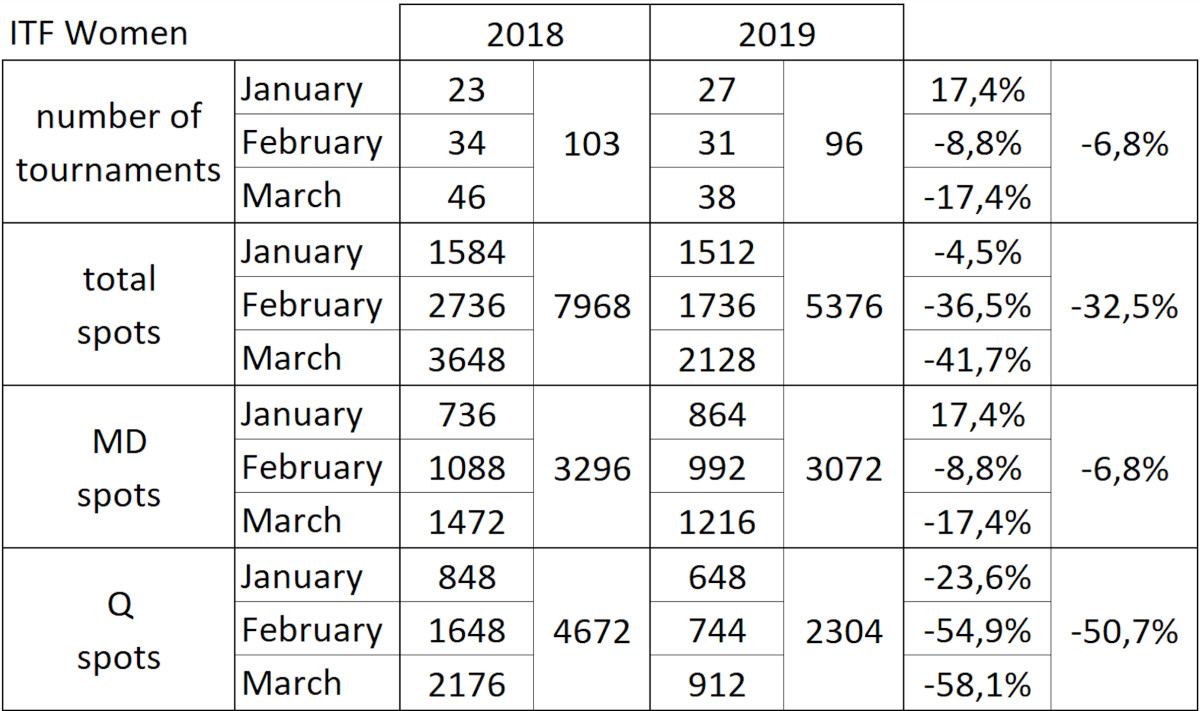Mailbag: Why the ITF World Tour Is an Unmitigated Disaster

Hello everyone…
HOUSEKEEPING
• The most recent Sports Illustrated/Tennis Channel podcast: Daily Show correspondent and former top-1000 player Michael Kosta talks comedy, tennis and border walls.
• Next up, world No. 5 Kevin Anderson.
• Many of you have asked me about Martina Navratilova and her comments about transgender athletes. I’m still educating myself and looking for data, but we can visit the topic in the coming weeks.
• Note the Reader Rant at the end about the travesty that is the ITF World Tour, a euphemism if ever there were one…
While we marvel at the recent play of Belinda Bencic, let's take some time to answer some questions…
MAILBAG
Have a question or comment for Jon? Email him at jon_wertheim@yahoo.com or tweet him @Jon_Wertheim.
I stumbled across this podcast from the BBC on tennis and match-fixing. It was gripping and may be of interest for the 'bag. I'd guess that part of the problem would evaporate if salaries were raised for the lower ranks of the tour(s) (where a raise has been on ice for decades now). I was struck by how banal and how brazen the match-fixing is.
—Andrew Miller, Silver Spring, Md.
• Thanks much. This is a good listen.
Some thoughts:
1. A lot of this distills to the basics of economics. We are creatures of incentive. When the prize money is x and the inducements to match-fix is 10x, you are asking for trouble. This is the libertarian in me, but any time you are asking people to act irrationally—e.g. expecting college athletes to play for free and decline payments, even though they are responsible for millions in commerce—you are asking for trouble.
2. You mention “salaries,” but who should bear this expense? The market is the market. And nowhere does it say that x number of players are entitled to earn a living as “pros.” If there’s no demand for fans to pay to watch guys ranked, say, 750-2,000, why should that be subsidized?
3. Especially sobering vis-a-vis not just tennis but sports wagering in general: thanks to live betting and microbetting, players don’t even have to lose a match. They can simply lose a set, a game or even a point.
4. Tennis did a horrible job of messaging this entire scenario. The vast majority of the corruption is occurring at the lowest levels. These tournaments are to Indian Wells what a dinner theater in Arkansas is to Broadway. Tennis needed to get in front of this and say, “We condemn this in the strongest terms. But these are hobbyists, who are no closer to playing Wimbledon than a subway musician is to La Scala.”
5. Just look at how this podcast is presented. It is titled, “Can we fix it? The inside story of match-fixing in tennis.” The graphis is a ball rolling across the clay of Roland Garros. You want to scream, “No! It should be a ball rolling across a cracked court in outer Tashkent!” Matchfixing is a terrible scourge. But let’s not conflate corruption at these subterranean events with anything at a major.
6. You can see why the ITF wanted to lop off ranking rolls and expel from the workforce the players who were not making a living as “pros,” and thus have incentive to cheat. But…
7. Note how the ITF dodged the question about live scoring at these Podunk events. No live scoring would essentially cut off the air supply for gambling on these matches. But this would impact the ITF’s “data partnership” that pays eight figures annually.
8. “Data partner” is code for “everyone is making money by gambling on our content and we want some of this lucre.” That’s fine. Sports wagering is currently legal in many countries (and eight U.S. states) and cultural views are shifting. But let’s call a “data partnership” what it is and stop positioning this as something virtuous.
9. Apropos of nothing, did anyone else notice that the ITF Independent Review final report—the report that asserts “In 2011, the TIU’s task was made more difficult by the ITF entering into a live scoring data sale agreement with Sportradar—was co-authored by Beth Wilkinson, who defended Brett Kavanaugh last fall?
With Agnieszka Radwanska's retirement, do you think the title of Tennis Ninja now goes to Hsieh Su-wei? Her shots are unconventional, she confounds her stronger opponents with guile, and at 33, she seems to be in midst of a singles career renaissance. I thoroughly enjoyed watching her wins against Angelique Kerber and Karolina Pliskova at Dubai (alas, she just lost to Petra Kvitova in the semis). Her style of play is a like a breath of fresh air.
—Dave Lu, Portland, Maine
• Hsieh Su-wei was in heavy rotation and we’re trying to figure out why. I suspect we have five different questions, all, quite rightly, praising her game. Which is great. Except that she is 33 years old. Why the sudden surge in interest?
Whatever the case, we are totally in the tank and happy to sing her praises. Here’s one (among countless) highlights.
Some of us probably project our own games here. We’re not hitting 120 mph serves, but it’s reassuring that even the top levels of the sport can accommodate angles and daring shotmaking. And in this case, it’s doubly reassuring that the player recognizes it as well. Her recent self-assessment:
“It’s always good to see more different styles of play on the tour because they give more fun. When we play against them, we feel more fun. You don't always want to play the same girl, who only do slice, or hit the big ball. It's boring for the fans, for me also!”
Here's an example of a player who got the raw end of the ITF World Tour situation: Peter Heller is a 26-year-old journeyman from Germany. He has played Futures consistently since 2011, with a high year-end ranking of 437, making about $80,000 total. Last year, finally healthy, he won six Futures titles and climbed to No. 273 by the end of the year—high enough to, most likely, get into Australian Open qualifying. But on Jan. 1, 2019, most of those ATP points from his ITF wins in 2018 were converted to ITF World Tour Points. His ATP ranking dropped to No. 589 and he's No. 2 in the ITF World ranking. He missed out on Aussie qualifying, and now he's back to paying 15ks and trying to claw his way back up the ladder he had just climbed. But now it's harder because even if he has the same success at the ITF level, he won't earn ATP points unless he wins 25ks. He made the final in a 25K in January and earned 1 ATP point. Last year, he would have earned 15 for the same result. He currently has 4 ATP points. I believe he would have received 25 points and $15,000 just for entering the Aussie Open qualifying, which would have put him at around No. 420 in the world. His high ITF ranking means he can get wild cards into Challenger main draws and qualifying, but it might be a risk to try to qualify for a challenger instead of entering a 15K, where he's more likely to win and maintain his (now precious) ITF World Ranking.
The week of the Aussie Open, he lost in the first round of a Challenger and made 225 euros…instead of $15,000 or more.
Poor guy!
—Megan, Indianapolis
• We need to commission a independent panel to study this “tour,” with designs of figuring out what can be done to restore opportunities and start to undo the chaos this has created. (Jump to the Reader Rant to hear from a player.) This was like a bill jammed through Congress with evil intent. Other legislators didn’t read the fine print before signing, and constituents didn’t realize the impact until it was too late.
Again, while we can debate whether the ITF acted honorably and for the good of the sport. But their motivations and incentives were obvious. Match-fixing had metastasized, each week brought a new low-level scandal and enforcement is expensive. (Especially when you are not willing to end the live scoring, which would imperil your millions in date revenue.)
But the great mystery: why did many other stakeholders, starting with the USTA, go along with a radical change that has—already, demonstrably—been catastrophic for American tennis?
I know you're a semi-proponent of Nick Kyrgios, but with his latest behavior at Delray, injured or not, he's starting to become indefensible. You're healthy as long as you're on the court. Otherwise, give it your all until you're forced to retire from the match.
There's a disconnect in his thought processes. People don't boo you for losing; people boo you for putting forth what looks like a lackluster effort. And his go-to comeback—that people shouldn't buy tickets to watch him play—fans buy tickets well ahead of the day and they're there to see a day's worth of matches, not just his.
Should the ATP come down hard with fines and sanctions to force Kyrgios to either shape up or become so irrelevant (see Tomic, Bernard) to the point where he's hardly in front of fans, or leave things as they are and let Kyrgios behave however he wants?
My take: If you don't want to be accountable to the public for workplace performance, go find an office cubicle somewhere. However, when people pay good money to watch you "work" (whether you want them to or not), you have a responsibility to them. Otherwise, I hear the ITF Futures circuit is pretty good for people who like to play tennis while being watched for free...
—James, Ho Chi Minh City
• Part of me asks if this is even worth discussion right now. The guy is ranked deep outside the top 50—he wasn’t seeded at Delray and is now No. 72—losing matches and relevance in equal measure. Part of me also feels like there is a mental health component to this story that gets elided, but is really at the heart of any discussion about his attitude, effort, motivation, conviction, etc.
In Australia, I was talking with someone who knows Kyrgios well, and this person suggested that Kyrgios doesn’t hate tennis; he just hates that it is an individual sport. Come again? Kyrgios doesn’t mind the ballstriking and the running and the overlaying of power and control. No, he minds that, unlike his beloved NBA, he has no teammates. That every match is a personal referendum, that he is exposed. Put him in the Laver Cup format and he thrives. He has buddies and he high-fives and if he loses, his teammates can still salvage victory.
When he’s out there alone, he’s uncomfortable. And one mechanism is tanking. “Hey, it doesn’t reflect on me because I didn’t try.” It’s like the kid in school who parties before the test. “It doesn’t reflect on my intelligence or my ability to synthesize information; I didn’t even study.”
That last time both male and female players won consecutive grand slam tournaments, a lot was happening in the female player's life, making headlines for the wrong reasons and trying to take control of her life. The male player had his own issues to deal with as well (not that she needs any, but in case Osaka needs any inspiration...).
—Neena
• Right. We talked about this last week but it’s worth a revisit. This is wild, no? Federer, Djokovic, Nadal and Serena have won 75 majors among them. But we’ve never had back-to-back men’s and women’s champs until Djokovic/Osaka, Djokovic/Osaka.
I'm encouraged to read Kevin Anderson's response to the question about plastic usage on the Tour. However, one of the biggest issues for tennis regarding sustainability is the air miles; the tennis industry is on planes all year round. That's a huge amount of greenhouse gases pumped into the atmosphere. A contributing factor is the haphazard calendar—a player might be in Melbourne in January, then off to who-knows-where for Davis Cup, then to Indian Wells, then to Miami, then all over Europe for several weeks, etc, not to mention travel home between those stops. If the tour plotted out a more sensible calendar it could save a lot of air miles, and therefore have a much lower eco-footprint. As many recent reports, such as the IPCC's, have made quite clear, this is a problem that can no longer be ignored or treated with lip service.
—Chris Brown, San Rafael, Calif.
• When we gush about the promise and world-is-flat opportunity occasioned by globalization, here’s another example of an unintended consequence. When the Tour wended from Miami to Tampa to Hilton Head to Atlanta to New Orleans to Dallas, the environmental footprint was a lot lighter than a circuit that goes from Melbourne to Dubai to Acapulco to Indian Wells. (When I was a kid and tennis came to my part of the world, I recall players carpooling and going by shuttle from Indianapolis to Cincinnati.)
I’m not sure what can be done here. Even in a sport less fractured than tennis, I’m not sure you’re changing up a calendar or neglecting markets for the sake of greenhouse gas reduction, worthy an exercise as that is. Instead I think you say, “We’re damaging the planet every time we step on a plane. What are we going to do the repair that in other respects.”
I was shocked to find that A. Rublev is languishing in the 100s. Was he not once a next-gen star?
Unrelated question: who would benefit from Severin Luthi's coaching after RF retires? (This inspired by all the coaching changes in tennis culture.)
—Ng,Canada
• Good question. He came to Indian Wells 2018 ranked No. 31; he is now No. 115. And it’s not like he’s been injured and missed big blocks of time. If anything, the guy is on the Dominic Thiem schedule. He went 20-23 last year. That’s a lot of events. The good news: he doesn’t turn 22 until October.
Interesting question on Luthi. Belinda Bencic is the first name that jumped to mind. In keeping with our coaching discussion over the last few weeks, it’s really more about the personality match than the X’s-and-O’s match. Here’s a guy who might not have been a Grand Slam champion himself—his ranking peaked at No. 622—but has spent much of the last two decades in a winning environment and is known as a companionable, level-headed, good guy. For the right player, male or female, he could be terrific.
You recently asked when was the last time both men and women won Slam X and then won Slam X+1.
I’m just nerdy enough to look it up (along with many others I’m sure) but I was very surprised to find out that goes all the way back to 1995, when Sampras and Graf each won Wimbledon and the U.S. Open back-to-back.
I was sure that with all the repeating the Big 3 (sorry Andy) have done over the past 15 years or so, it would be Serena and one of those guys. Yikes!
I’m sure dozens of others sent you this info.
—Gavin
• Can’t get enough of this one.
In support of last mailbag's reader rant, here's Pete Bodo on the same subject.
Looks like assuming surface homogeneity stays the same, we could be looking at 16-18 slams minimum to enter the 'great player' club, as opposed to the 8-12 that was the norm just a decade ago.
—Parag
• We said it before, we say it again. We stop at nothing to link Pete Bodo.
• As a lifelong fan of both Roger Federer and Duke basketball, I was pleasantly surprised to see that Federer was a guest on Coach K's radio show. Just wanted to shout out this fascinating interview for fans (especially Sirius XM members) on the day of the first Duke-North Carolina game of the year!
—Suny G.
• Thanks much.
With the breakthrough win by Reilly Opelka last week at the New York Open, and with such huge upside considering he is only 21, I started wondering whether a player taller than 6'8" will ever win a Grand Slam singles title or become No. 1 (I know the two generally go hand-in-hand, on the men's side especially). I think as long as the slams are best-of-five for the entire tournament, I don't see it happening any time soon. What do you think?
—Anthony C. Anegon, Lewiston, Idaho
• Surface is critical. If it’s going to happen, it’s going to happen on grass. And you’re right that best-of-five is an impediment. (Though the new rules against playing out the decisive set swing the pendulum back a bit.)
I share your skepticism. Yes, the serve is an asset. Not just the free points, but the free points that don’t entail much movement. But movement is so critical today, it’s hard to picture anyone lumbering for 21 triumphant sets.
SHOTS, MISCELLANY
• If you missed it, here’s Serena Williams at the Oscars.
• Tennis Season has officially arrived in the Coachella Valley, and the Indian Wells Tennis Garden is in full bloom as the festivities surrounding the 2019 BNP Paribas Open get underway in the coming days and weeks. The picturesque venue is bursting with greenery, palm trees, flower walls, and even a Secret Garden ahead of the main event, to be held March 4-17.
• FILA announced today that it has reached a sponsorship agreement with former world No. 2 Tommy Haas, who won 15 singles titles and captured more than 500 match wins in his career.
• Southern California native and Orange County Breakers owner Eric Davidson has been named World TeamTennis’ new Chairman of the Board while acquiring an ownership share in the world’s foremost team tennis organization. Davidson, a 57-year-old resident of Laguna Beach, Calif., currently shares the largest stake of ownership in the league with San Diego Aviators owner Fred Luddy, while league founder and tennis legend Billie Jean King also remains a co-owner of WTT.
• The Arizona Tennis Classic and the Association of Tennis Professionals (ATP), announced Monday the initial 41 players who have accepted invites to play at the inaugural tournament happening at Phoenix Country Club from March 11-17. The first Arizona Tennis Classic will feature players competing in a 48-player singles draw and a 16-team doubles draw.
Most notably, the event has attracted seven players ranked in the top 50 in men’s tennis worldwide. These players include: Matthew Ebden (Australia), Martin Klizan (Slovakia), Malek Jaziri (Tunisia), Nicholas Jarry (Chile), Matteo Berrettini (Italy), Damir Dzumhur (Bosnia) and Mikhail Kukushkin (Kazakhstan).
Also, there are more than 23 players ranked in the world’s top 100 set to play at this event, including four Americans: Bradley Klahn, Ryan Harrison, Jared Donaldson and Bjorn Fratangelo.
• Here’s Eva Asderaki Moore on the Southpaw Slice podcast.
LONG-LOST SIBLINGS
• From Christopher: Belinda Bencic and the Haim sisters, especially Alana.

READER RANT
• From Maria Maria Patrascu, a Canadian professional tennis player:
Last year I started a petition going against the changes of the new ITF World Tennis Tour that is currently affecting thousands in the tennis community. I am reaching out to you to kindly ask for your public support in our movement. I noticed that you have already begun to speak out about it on Twitter.
Here are some important points to know:
1. Our petition has gathered 7,000+ signatures in the last two weeks alone and we are expecting to hit 10,000 signatures in the next couple days. I am doing my best to use this milestone as an opportunity to reach out to different media outlets like yours in hopes of getting attention.
2. Myself and a small group of players are working very hard to raise awareness and make a change. We also have two different Facebook groups up (a closed group: Players vs ITF, and a public group: Change ITF Rules) which each have over 1.2K+ members. We also started an Instagram account @PlayersVsITF which has 1k+ followers.
3. We publicly have the support of the German tennis VP Dirk Hordorff and the Austrian tennis president Raimund Stefanits
4. A big change is that ITF tournaments have a 24-player qualifying draw (reduced greatly from previous larger draw sizes) and the only solution to allow more players to enter is for tournament organizers to host optional pre-qualifying tournaments. They are disastrous. My close friends played one in Tunisia recently and their pre-qualifying was so big (32-person draw, meaning four matches just to get into the official qualies and six matches total in order to make it to the main draw) that they started matches the evening of the sign-in. The first rotation had only 10mins notice to get on court to compete. There were also no-ADs at deuce and the third set was a super-tiebreaker.
The negative impact this is having on the tennis community is already huge, and with every day that passes players are getting more worried. One of the main issues is, as of right now between the tournaments from January-March, there is more than 50% decrease in total spots available for men and women in all ITF’s combined.


Sincerely,
Maria Patrascu
